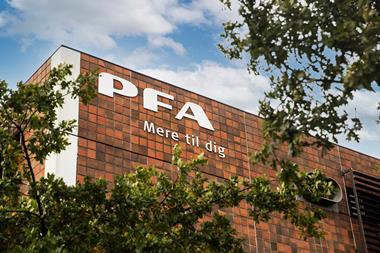The two pension funds run by Denmark’s LD Pensions (LD Fonde) were hit by losses of around 8% last year, but saved from steeper declines by gains the manager made on inflation hedging as well as rising valuations of loan assets belonging to the newer fund.
Reporting 2022 full-year financial results on Friday, LD Pensions said the older Cost-of-Living Allowance Fund (Lønmodtagernes Dyrtidsmidler) ended the year with a -8.2% return while the newer Holiday Allowance Fund (Lønmodtagernes Feriemidler) ended with a -7.9% loss.
The reported Cost-of-Living Allowance Fund result is based on the balanced fund LD Discretionary (LD Vælger), which represents the bulk of the fund’s overall investment assets.
Lars Mayland Nielsen, chief executive officer of the Frederiksberg-based pension fund manager, said: “We would really have liked it not to be the case that members’ savings lost value in 2022, but the result is satisfactory in relation to market development.”
He said the result had been among the “absolute best” in 2022, when compared with listed investment funds in Denmark with a mixed portfolio of bonds and shares.
LD Pensions said positive returns had been achieved on inflation hedging and revaluation of the holiday funds that employers have chosen to keep within their businesses.
“Together with a robust portfolio composition, this has mitigated the negative development on the financial markets,” the firm said.
In the holiday scheme, employers can either pass the money due to staff upfront to LD Pensions to manage, or they can keep it as working capital in their businesses until employees retire. In the latter case, the assets are treated as a loan to the companies.
LD said the indexing of holiday funds receivable from employers had contributed 2.2% to the total return on member assets in that fund.
Within the investment portfolio for the holiday fund, the credit portfolio performed strongest last year with a -7.1% loss, the firm said, while high-grade bonds lost -13.1%, and equities lost -12.3%.
“The credit portfolio’s weight in the portfolio was increased during the year, and the portfolio gradually became better diversified,” LD Pensions said.
Meanwhile in LD Discretionary, the credit portfolio lost -4.6% and high-grade bonds lost -9.5%.
“The loss was limited by the fact that part of the portfolio is invested in inflation-indexed bonds,” LD Pensions said.
Equities ended the year in the red to the tune of -12.3%, it reported.
LD Pensions’ total assets – including those held by employers in the holiday scheme – fell to DKK79.8bn (€10.7bn) at the end of December from DKK95.3bn a year before.
Sampension achieves 3.4% gain so far in 2023, making up for some 2022 losses
Labour-market pension provider Sampension reported that average returns for market-rate pensions in 2022 were -7.3%, but that investments had already recouped some of last year’s losses in the first two months of this year.
In its annual results statement this morning, Sampension said that for customers with market-rate pension products, the return had been between -6.1% and -9.4%, depending on customer profile.
Hasse Jørgensen, Sampension’s CEO, said: “In 2022, there was severe unrest on the financial markets, where we witnessed – quite unusually – losses on both shares and bonds as a result of the war in Ukraine, the energy crisis, rising interest rates and sky-high inflation.”
But the Copenhagen-based firm said the markets had got off to a good start in 2023.
“So the year-to-date return for a customer with Sampension, who has 15 years to pension age and medium risk is 3.4%,” as of 27 February, the firm said.
Total assets managed by Sampension – including its main life and pensions arm, Sampension Liv as well as the two independent pension funds it runs – fell to DKK315bn after 2022 from DKK354bn at the end of 2021.
Those two pension funds are the Pension Fund for Architects and Designers (Pensionskassen Arkitekter & Designere) and the Pension Fund for Agricultural Academics and Vets (Pensionskassen for Jordbrugsakademikere & Dyrlæger).
PenSam says 2022 showed benefits of average-rate pensions
PenSam revealed its bonus potential shrank to less than half of its previous size in the course of 2022, after investment losses of -9.6%, but said the tumultuous year had highlighted the benefits of average-rate pensions – the type of product it manages.
In annual results published on Friday, PenSam – which covers mainly public sector workers in the health, social care and education sectors – said its key Fleksion average-rate pension product had lost -9.6% before tax last year.
However, pension payments from the product had been increased by 9% in 2023.
PenSam said the pension schemes it managed were average-rate products, where the investment return was equalised between years, with the return is typically levelled over a five-year period.
“It is in years like 2022 that an average-rate product shows its good qualities,” the firm said.
Total assets for its main pensions business, PenSam Pension, fell to DKK171bn in 2022 from DKK179bn, while the unit’s bonus potential diminished to DKK15.3bn from DKK34.5bn.
Solvency coverage fell to 440% from 1,061%, it reported.
To read the digital edition of IPE’s latest magazine click here
























